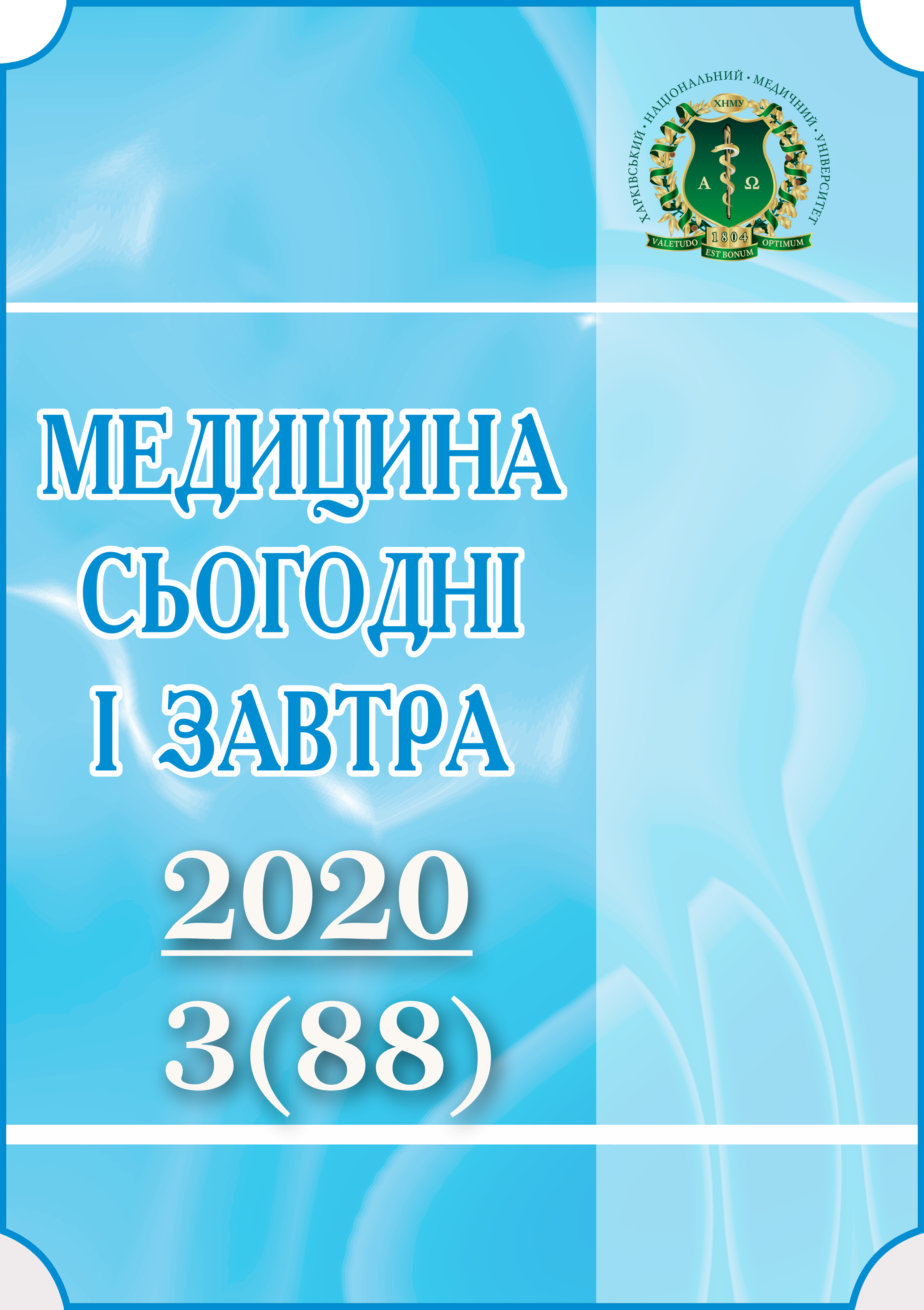Abstract
The dynamics of C-reactive protein (CRP) blood level after hemioplasty and simultaneous interventions with principles of "Fast-track surgery" in the perioperative period was studied. The dynamics of CRP blood level in 60 patients in whom the principles of "Fast-track surgery" were applied, including a thorough examination before the operation to diagnose combined abdominal pathology and clinically significant general somatic pathology; if necessary, prescribe a course of therapy for full compensation of general somatic pathology; during the operation of epidural prolonged anesthesia; choice in favor of laparoscopic technology; at the end of the operation of irrigation of the subphrenic space by local anesthetic; after surgery: early removal of drainage, opioid withdrawal with the appointment of parenteral paracetamol; in inguinal hemioplasty – prolonged local anesthesia after surgery; activation of the patient in 6-8 hours after operation; on the day of surgery – the use of chewing gum and fluid intake and from the first day – intake of low-calorie liquid food. Traditional perioperative management methods were used in 67 patients. It was found that in patients who underwent hernia plastics, there is an increase in the concentration of CRP in the postoperative period, which is one of the manifestations of the systemic inflammatory response, and especially pronounced after simultaneous operations. The use of the principles of «Fast-track surgery» in the complex of perioperative support contributes to better normalization of CRP concentration and faster elimination of the manifestations of systemic inflammatory response.
Keywords: hemioplasty, simultaneous operations, C-reactive protein, "Fast-track surgery".
References
Donskova, Ju. S. (2012). Diahnosticheskoie i prohnosticheskoie znacheniie biolohicheskikh markerov sistemnoi vospalitelnoi reaktsii i sepsisa v onkokhimrhii (obzor literatury) [Diagnostic and prognostic role of biomarkers of systemic inflammatory response and sepsis in oncosurgery], Onkokhirurhiia – Oncosurgery, 4(l), 65–72. Retrieved from www.oncology.ru/specialist/joumal_oncology/archive/2012/59 [in Russian],
Finnerty, C., Mabvuure, N.T., Ali, A., Kozar, R.A., & Herndon, D.N. (2013). The surgically induced stress response. J. Parent, and Enteral Nutrit., 379(55), 21S–29S. DOI: 10.1177/0148607113496117. PMID: 24009246.
Ansari, D., Gianotti, L., Schroder, J., & Andersson, R. (2013). Fast-track surgery: procedure-specific aspects and future direction. Langenheck’s Archives of Surgery, vol. 398, issue 1, pp. 29-37. DOI: 10.1007/s00423-012-1006-9, PMID: 23014834.
Kokotovic D., Burcharth J., Helgstrand F., Gogenur I. (2017). Systemic inflammatory response after hernia repair: a systematic review. Langenheck’s Archives of Surgery, 402(7), 1023–1037. DOI: 10.1007/s00423-017-1618-1. PMID: 28831565.
Watt, D.G., Horgan, P.G., & McMillan, D.C. (2015). Routine clinical markers of the magnitude of the systemic inflammatory response after elective operation: a systematic review. Surgery, 157(2), 362–380. DOI: 10.1016/j.surg.2014.09.009. PMID: 25616950.
St. John, A., Caturegli, K., Kubicki, N.S., & Kavic, S.M. (2020). The rise of minimally invasive surgery: 16 year analysis of the progressive replacement of open surgery with laparoscopy. JSLS, 24(4), e2020.00076. DOI: 10.4293/JSLS.2020.00076. PMID: 33510568.
Galimov, O.V., Khanov, V.O., Mamadaliev, D.Z., Sayfullin, R.R., & Sagitdinov, R.R. (2017). Kreativnaia khimrgiia gryzhi pishchevodnogo otverstiia diafragmy [Creative surgery for hiatal hernia]. PRJS, (7), 30–32. DOI: 10.17116/ hirurgia2017730-32. PMID: 28745703 [in Russian],
Ozmen, M. M., Zulfikaroglu, B., Col, C., Cinel, I., Isman, F. K., Cinel, L., & Besler, T. H. (2009). Effect of increased abdominal pressure on cytokines (IL1 beta, IL6, TNFalpha), C-reactive protein (CRP), free radicals (NO, MDA), and histology. Surgical laparoscopy, endoscopy & percutaneous techniques, 19(2), 142–147. DOI: 10.1097/SLE.0b013e31819cdda7. PMID: 19390282.
Nanavati, A.J., & Prabhakar, S. (2014). A comparative study of 'fast-track' versus traditional peri-operative care protocols in gastrointestinal surgeries. J. Gastrointest. Surg., 18(4), 757–767. DOI: 10.1007/sl1605-013-2403-2. PMID: 24222323.
Jurt, J., Slieker, J., Frauche, P, Addor, V., Sola, J., Demartines, N., & Hubner, M. (2017). Enhanced recovery after surgery: Can we rely on the key factors or Do we need the bel ensemble? World J. Surg., 41(10), 2464–2470. DOI: 10.1007/s00268-017-4054-z. PMID: 28492998.
Slim, K., & Standaert, D. (2020). Enhanced recovery after surgical repair of incisional hernias. Hernia, 24(1), 3–8. DOI: 10.1007/sl0029-019-01992-y. PMID: 31177341.
Symeonidis, D., Diamantis, A., Baloyiannis, I., Tzovaras, G., & Tepetes, K. (2020). Systemic immune response after open tension-free inguinal hernia repair under different anesthetic alternatives: a prospective comparative study. G. Chir., 41 (1), pp. 103–109. PMID: 32038020.
Steams, E., Plymale, M.A., Davenport, D.L., Totten, C., Carmichael, S.P, Tancula, C.S., & Roth, J.S. (2018). Early outcomes of an enhanced recovery protocol for open repair of ventral hernia. Surg. Endosc., 32, (6), 2914–2922. DOI: 10.1007/s00464-017-6004-0. PMID: 29270803.
Ueland, W., Walsh-Blackmore, S., Nisiewicz, M., Davenport, D.L., Plymale, M.A., Plymale, M., Roth, J.S. (2020). The contribution of specific enhanced recovery after surgery (ERAS) protocol elements to reduced length of hospital stay after ventral hernia repair. Surg. Endosc., 34(10), 4638–4644. DOI: 10.1007/s00464-019-07233-8. PMID: 31705287.
Kahokehr, A., Sammour, T., Soop, M., & Hill, A.G. (2010). Intraperitoneal use of local anesthetic in laparoscopic cholecystectomy: Systematic review and metaanalysis of randomized controlled trials. J. Hepatobiliary Pancreat. Sci., 17(5), 637–656. DOI: 10.1007/s00534-010-0271-7. PMID: 20393755.
Jensen, K.K., Brondum, T.L., Leerhoy, B., Belhage, B., Hensler, M., Amesen, R.B. et al. (2020). Preoperative, single, high-dose glucocorticoid administration in abdominal wall reconstruction: a randomized, double-blinded clinical trial. Surgery, 167(4), 757–764. DOI: 10.1016/ j.surg.2019.12.007.
Gelman, D., Gelmanas, A., Urbanaite, D., Tamosiunas, R., Sadauskas, S., & Bilskiene, D. (2018). Role of multimodal analgesia in the evolving enhanced recovery after surgery pathways. Medicina (Kaunas), 54(2), art. 20. DOI: 10.3390/medicina54020020. PMID: 30344251.
McGlory, G., Davis, A.E., & Kirksey, K.M. (2018). Multimodal analgesia in critical care. Nursing Critical Care, 13(2), 18–23. DOI: 10.1097/01.CCN.0000527222.11558.c3.
Ge, W., Chen, G., & Ding, Y.T. (2015). Effect of chewing gum on the postoperative recovery of gastrointestinal function. Intern. J. Clin. Experim. Med., 8(8), 11936–11942. PMID: 26550107.

